Organizational Sustainability: HerbaLine Facial Spa Case Study
VerifiedAdded on 2021/06/16
|10
|2433
|17
Case Study
AI Summary
This case study analyzes the organizational sustainability practices of HerbaLine, a rapidly growing beauty spa in Malaysia, focusing on its human resource strategies. The analysis evaluates three key HR initiatives: training programs, benefits and incentives, and fostering a healthy corporate culture. It examines the authenticity and contribution of these initiatives to positive social and human outcomes, such as increased employee engagement and reduced turnover. The study also compares how these initiatives might differ in a small versus a large business context, highlighting the importance of employee well-being and its impact on customer experience and business success. The conclusion emphasizes the effectiveness of these practices in enhancing the business environment and offers implications for future HR strategies.
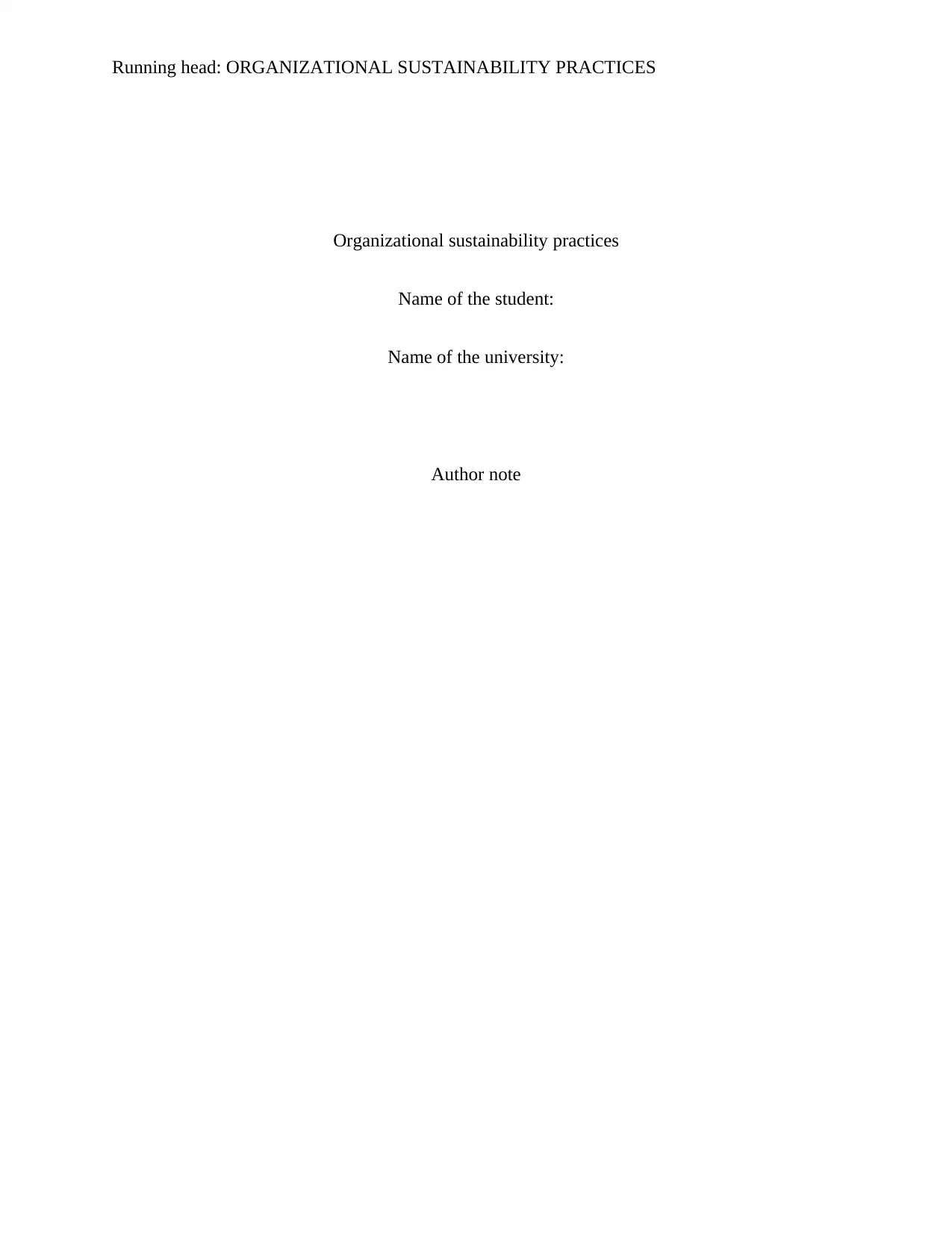
Running head: ORGANIZATIONAL SUSTAINABILITY PRACTICES
Organizational sustainability practices
Name of the student:
Name of the university:
Author note
Organizational sustainability practices
Name of the student:
Name of the university:
Author note
Paraphrase This Document
Need a fresh take? Get an instant paraphrase of this document with our AI Paraphraser
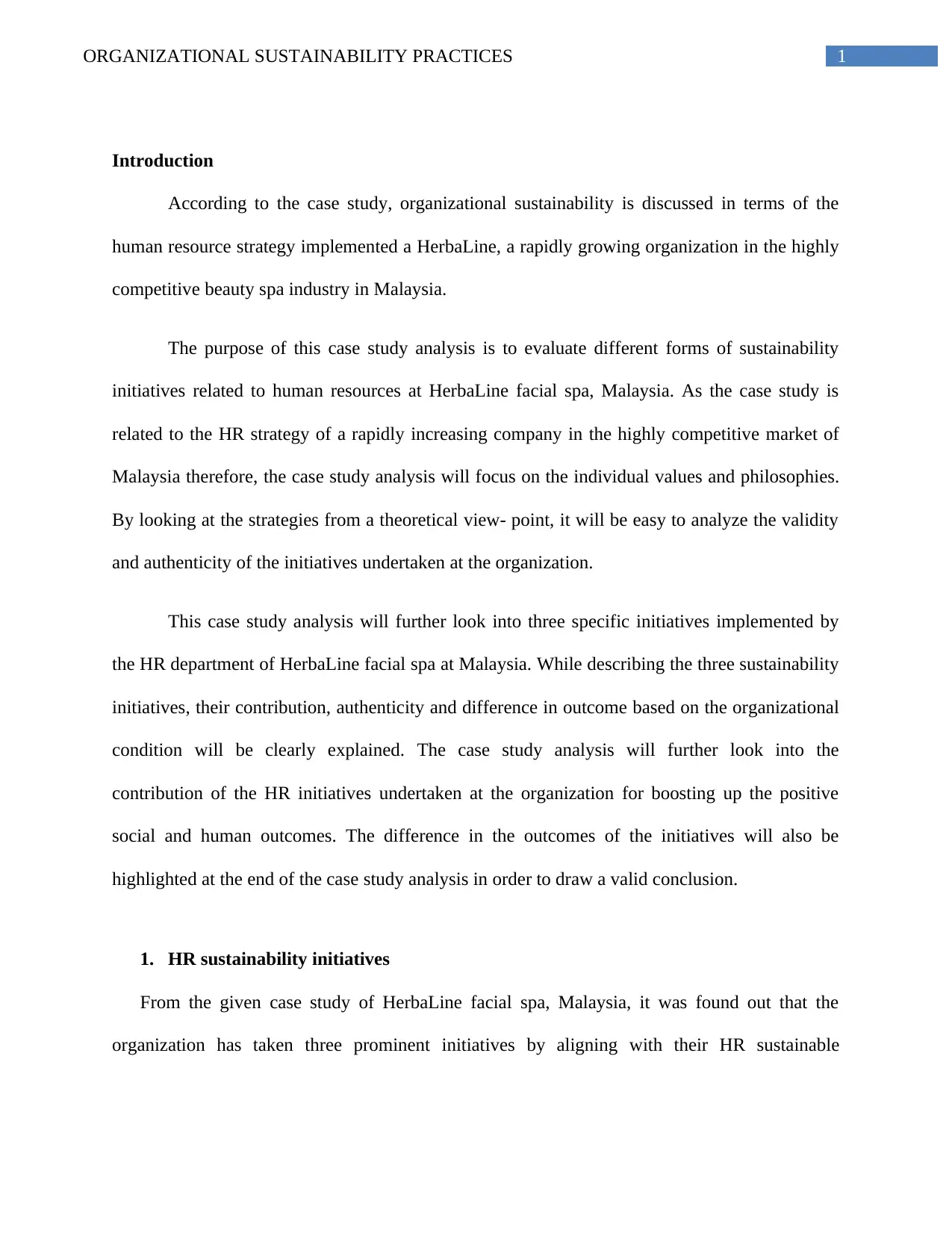
1ORGANIZATIONAL SUSTAINABILITY PRACTICES
Introduction
According to the case study, organizational sustainability is discussed in terms of the
human resource strategy implemented a HerbaLine, a rapidly growing organization in the highly
competitive beauty spa industry in Malaysia.
The purpose of this case study analysis is to evaluate different forms of sustainability
initiatives related to human resources at HerbaLine facial spa, Malaysia. As the case study is
related to the HR strategy of a rapidly increasing company in the highly competitive market of
Malaysia therefore, the case study analysis will focus on the individual values and philosophies.
By looking at the strategies from a theoretical view- point, it will be easy to analyze the validity
and authenticity of the initiatives undertaken at the organization.
This case study analysis will further look into three specific initiatives implemented by
the HR department of HerbaLine facial spa at Malaysia. While describing the three sustainability
initiatives, their contribution, authenticity and difference in outcome based on the organizational
condition will be clearly explained. The case study analysis will further look into the
contribution of the HR initiatives undertaken at the organization for boosting up the positive
social and human outcomes. The difference in the outcomes of the initiatives will also be
highlighted at the end of the case study analysis in order to draw a valid conclusion.
1. HR sustainability initiatives
From the given case study of HerbaLine facial spa, Malaysia, it was found out that the
organization has taken three prominent initiatives by aligning with their HR sustainable
Introduction
According to the case study, organizational sustainability is discussed in terms of the
human resource strategy implemented a HerbaLine, a rapidly growing organization in the highly
competitive beauty spa industry in Malaysia.
The purpose of this case study analysis is to evaluate different forms of sustainability
initiatives related to human resources at HerbaLine facial spa, Malaysia. As the case study is
related to the HR strategy of a rapidly increasing company in the highly competitive market of
Malaysia therefore, the case study analysis will focus on the individual values and philosophies.
By looking at the strategies from a theoretical view- point, it will be easy to analyze the validity
and authenticity of the initiatives undertaken at the organization.
This case study analysis will further look into three specific initiatives implemented by
the HR department of HerbaLine facial spa at Malaysia. While describing the three sustainability
initiatives, their contribution, authenticity and difference in outcome based on the organizational
condition will be clearly explained. The case study analysis will further look into the
contribution of the HR initiatives undertaken at the organization for boosting up the positive
social and human outcomes. The difference in the outcomes of the initiatives will also be
highlighted at the end of the case study analysis in order to draw a valid conclusion.
1. HR sustainability initiatives
From the given case study of HerbaLine facial spa, Malaysia, it was found out that the
organization has taken three prominent initiatives by aligning with their HR sustainable
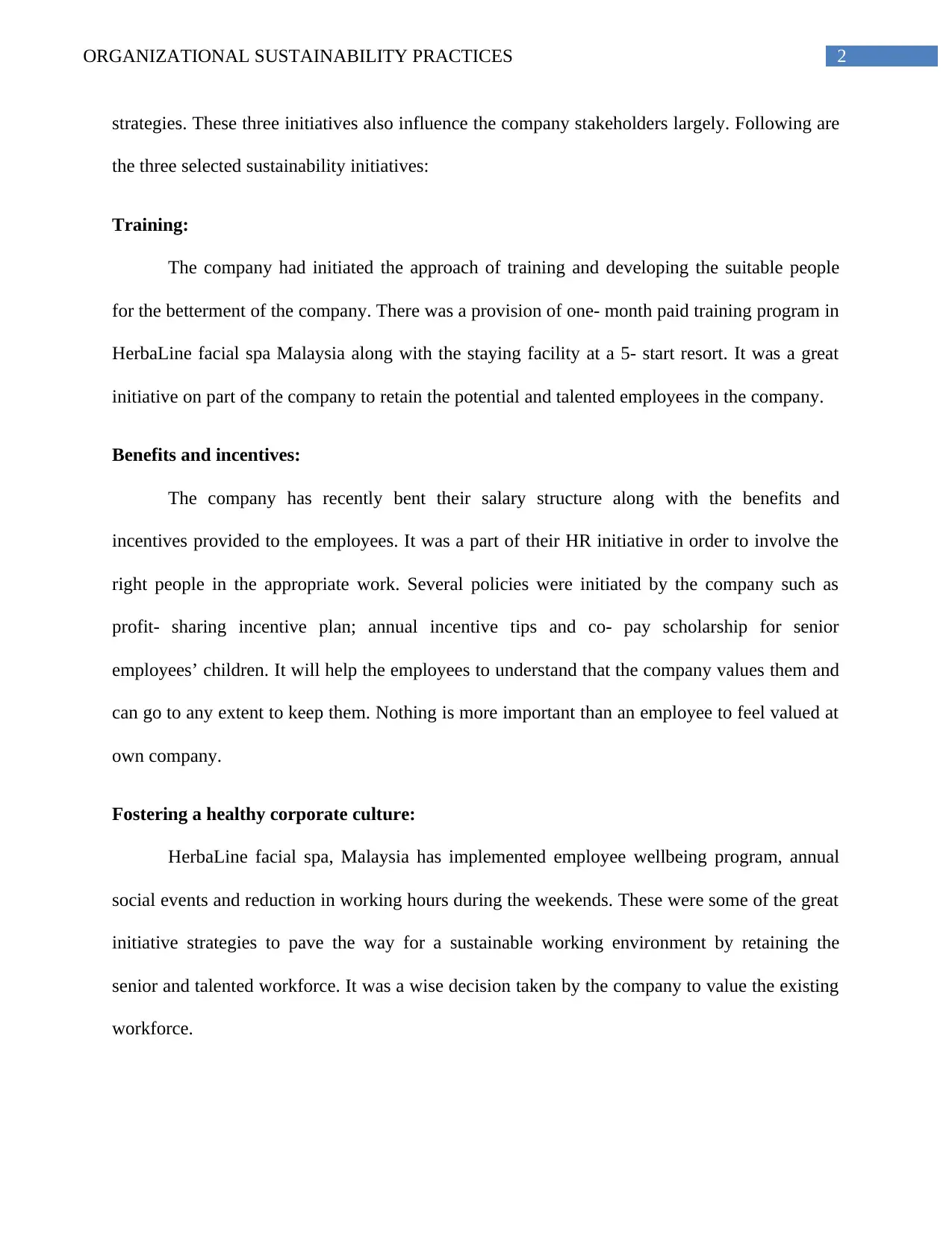
2ORGANIZATIONAL SUSTAINABILITY PRACTICES
strategies. These three initiatives also influence the company stakeholders largely. Following are
the three selected sustainability initiatives:
Training:
The company had initiated the approach of training and developing the suitable people
for the betterment of the company. There was a provision of one- month paid training program in
HerbaLine facial spa Malaysia along with the staying facility at a 5- start resort. It was a great
initiative on part of the company to retain the potential and talented employees in the company.
Benefits and incentives:
The company has recently bent their salary structure along with the benefits and
incentives provided to the employees. It was a part of their HR initiative in order to involve the
right people in the appropriate work. Several policies were initiated by the company such as
profit- sharing incentive plan; annual incentive tips and co- pay scholarship for senior
employees’ children. It will help the employees to understand that the company values them and
can go to any extent to keep them. Nothing is more important than an employee to feel valued at
own company.
Fostering a healthy corporate culture:
HerbaLine facial spa, Malaysia has implemented employee wellbeing program, annual
social events and reduction in working hours during the weekends. These were some of the great
initiative strategies to pave the way for a sustainable working environment by retaining the
senior and talented workforce. It was a wise decision taken by the company to value the existing
workforce.
strategies. These three initiatives also influence the company stakeholders largely. Following are
the three selected sustainability initiatives:
Training:
The company had initiated the approach of training and developing the suitable people
for the betterment of the company. There was a provision of one- month paid training program in
HerbaLine facial spa Malaysia along with the staying facility at a 5- start resort. It was a great
initiative on part of the company to retain the potential and talented employees in the company.
Benefits and incentives:
The company has recently bent their salary structure along with the benefits and
incentives provided to the employees. It was a part of their HR initiative in order to involve the
right people in the appropriate work. Several policies were initiated by the company such as
profit- sharing incentive plan; annual incentive tips and co- pay scholarship for senior
employees’ children. It will help the employees to understand that the company values them and
can go to any extent to keep them. Nothing is more important than an employee to feel valued at
own company.
Fostering a healthy corporate culture:
HerbaLine facial spa, Malaysia has implemented employee wellbeing program, annual
social events and reduction in working hours during the weekends. These were some of the great
initiative strategies to pave the way for a sustainable working environment by retaining the
senior and talented workforce. It was a wise decision taken by the company to value the existing
workforce.
⊘ This is a preview!⊘
Do you want full access?
Subscribe today to unlock all pages.

Trusted by 1+ million students worldwide
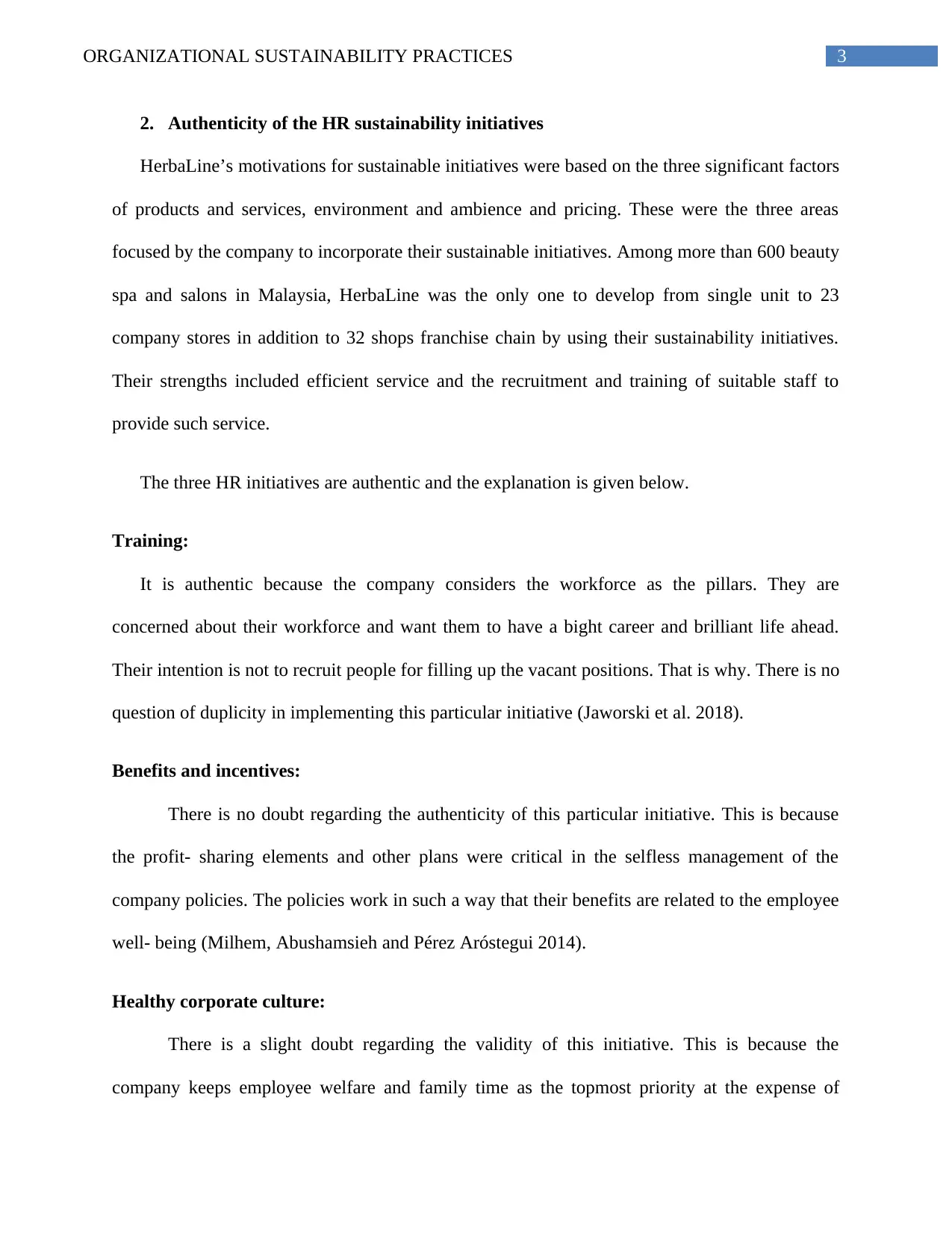
3ORGANIZATIONAL SUSTAINABILITY PRACTICES
2. Authenticity of the HR sustainability initiatives
HerbaLine’s motivations for sustainable initiatives were based on the three significant factors
of products and services, environment and ambience and pricing. These were the three areas
focused by the company to incorporate their sustainable initiatives. Among more than 600 beauty
spa and salons in Malaysia, HerbaLine was the only one to develop from single unit to 23
company stores in addition to 32 shops franchise chain by using their sustainability initiatives.
Their strengths included efficient service and the recruitment and training of suitable staff to
provide such service.
The three HR initiatives are authentic and the explanation is given below.
Training:
It is authentic because the company considers the workforce as the pillars. They are
concerned about their workforce and want them to have a bight career and brilliant life ahead.
Their intention is not to recruit people for filling up the vacant positions. That is why. There is no
question of duplicity in implementing this particular initiative (Jaworski et al. 2018).
Benefits and incentives:
There is no doubt regarding the authenticity of this particular initiative. This is because
the profit- sharing elements and other plans were critical in the selfless management of the
company policies. The policies work in such a way that their benefits are related to the employee
well- being (Milhem, Abushamsieh and Pérez Aróstegui 2014).
Healthy corporate culture:
There is a slight doubt regarding the validity of this initiative. This is because the
company keeps employee welfare and family time as the topmost priority at the expense of
2. Authenticity of the HR sustainability initiatives
HerbaLine’s motivations for sustainable initiatives were based on the three significant factors
of products and services, environment and ambience and pricing. These were the three areas
focused by the company to incorporate their sustainable initiatives. Among more than 600 beauty
spa and salons in Malaysia, HerbaLine was the only one to develop from single unit to 23
company stores in addition to 32 shops franchise chain by using their sustainability initiatives.
Their strengths included efficient service and the recruitment and training of suitable staff to
provide such service.
The three HR initiatives are authentic and the explanation is given below.
Training:
It is authentic because the company considers the workforce as the pillars. They are
concerned about their workforce and want them to have a bight career and brilliant life ahead.
Their intention is not to recruit people for filling up the vacant positions. That is why. There is no
question of duplicity in implementing this particular initiative (Jaworski et al. 2018).
Benefits and incentives:
There is no doubt regarding the authenticity of this particular initiative. This is because
the profit- sharing elements and other plans were critical in the selfless management of the
company policies. The policies work in such a way that their benefits are related to the employee
well- being (Milhem, Abushamsieh and Pérez Aróstegui 2014).
Healthy corporate culture:
There is a slight doubt regarding the validity of this initiative. This is because the
company keeps employee welfare and family time as the topmost priority at the expense of
Paraphrase This Document
Need a fresh take? Get an instant paraphrase of this document with our AI Paraphraser
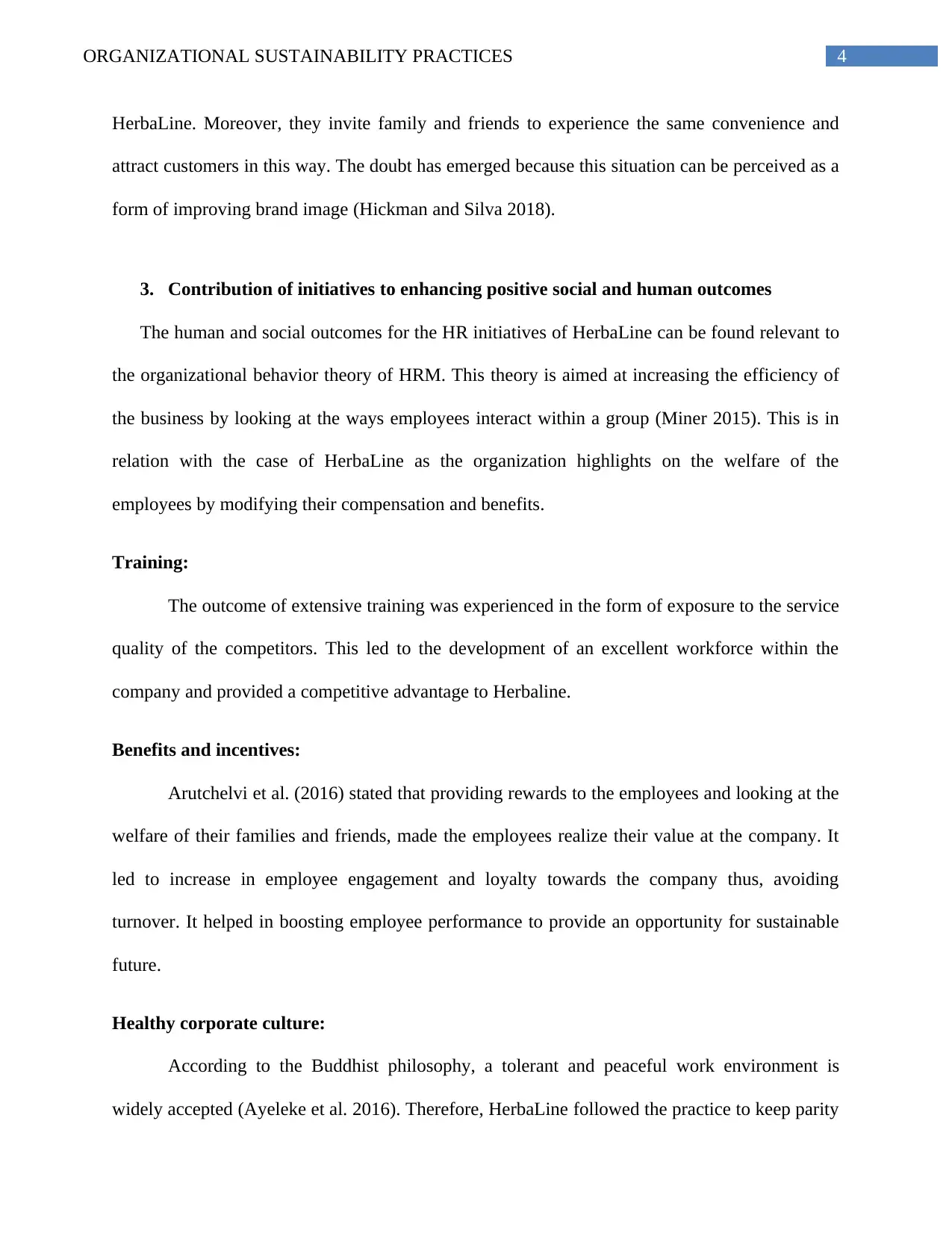
4ORGANIZATIONAL SUSTAINABILITY PRACTICES
HerbaLine. Moreover, they invite family and friends to experience the same convenience and
attract customers in this way. The doubt has emerged because this situation can be perceived as a
form of improving brand image (Hickman and Silva 2018).
3. Contribution of initiatives to enhancing positive social and human outcomes
The human and social outcomes for the HR initiatives of HerbaLine can be found relevant to
the organizational behavior theory of HRM. This theory is aimed at increasing the efficiency of
the business by looking at the ways employees interact within a group (Miner 2015). This is in
relation with the case of HerbaLine as the organization highlights on the welfare of the
employees by modifying their compensation and benefits.
Training:
The outcome of extensive training was experienced in the form of exposure to the service
quality of the competitors. This led to the development of an excellent workforce within the
company and provided a competitive advantage to Herbaline.
Benefits and incentives:
Arutchelvi et al. (2016) stated that providing rewards to the employees and looking at the
welfare of their families and friends, made the employees realize their value at the company. It
led to increase in employee engagement and loyalty towards the company thus, avoiding
turnover. It helped in boosting employee performance to provide an opportunity for sustainable
future.
Healthy corporate culture:
According to the Buddhist philosophy, a tolerant and peaceful work environment is
widely accepted (Ayeleke et al. 2016). Therefore, HerbaLine followed the practice to keep parity
HerbaLine. Moreover, they invite family and friends to experience the same convenience and
attract customers in this way. The doubt has emerged because this situation can be perceived as a
form of improving brand image (Hickman and Silva 2018).
3. Contribution of initiatives to enhancing positive social and human outcomes
The human and social outcomes for the HR initiatives of HerbaLine can be found relevant to
the organizational behavior theory of HRM. This theory is aimed at increasing the efficiency of
the business by looking at the ways employees interact within a group (Miner 2015). This is in
relation with the case of HerbaLine as the organization highlights on the welfare of the
employees by modifying their compensation and benefits.
Training:
The outcome of extensive training was experienced in the form of exposure to the service
quality of the competitors. This led to the development of an excellent workforce within the
company and provided a competitive advantage to Herbaline.
Benefits and incentives:
Arutchelvi et al. (2016) stated that providing rewards to the employees and looking at the
welfare of their families and friends, made the employees realize their value at the company. It
led to increase in employee engagement and loyalty towards the company thus, avoiding
turnover. It helped in boosting employee performance to provide an opportunity for sustainable
future.
Healthy corporate culture:
According to the Buddhist philosophy, a tolerant and peaceful work environment is
widely accepted (Ayeleke et al. 2016). Therefore, HerbaLine followed the practice to keep parity
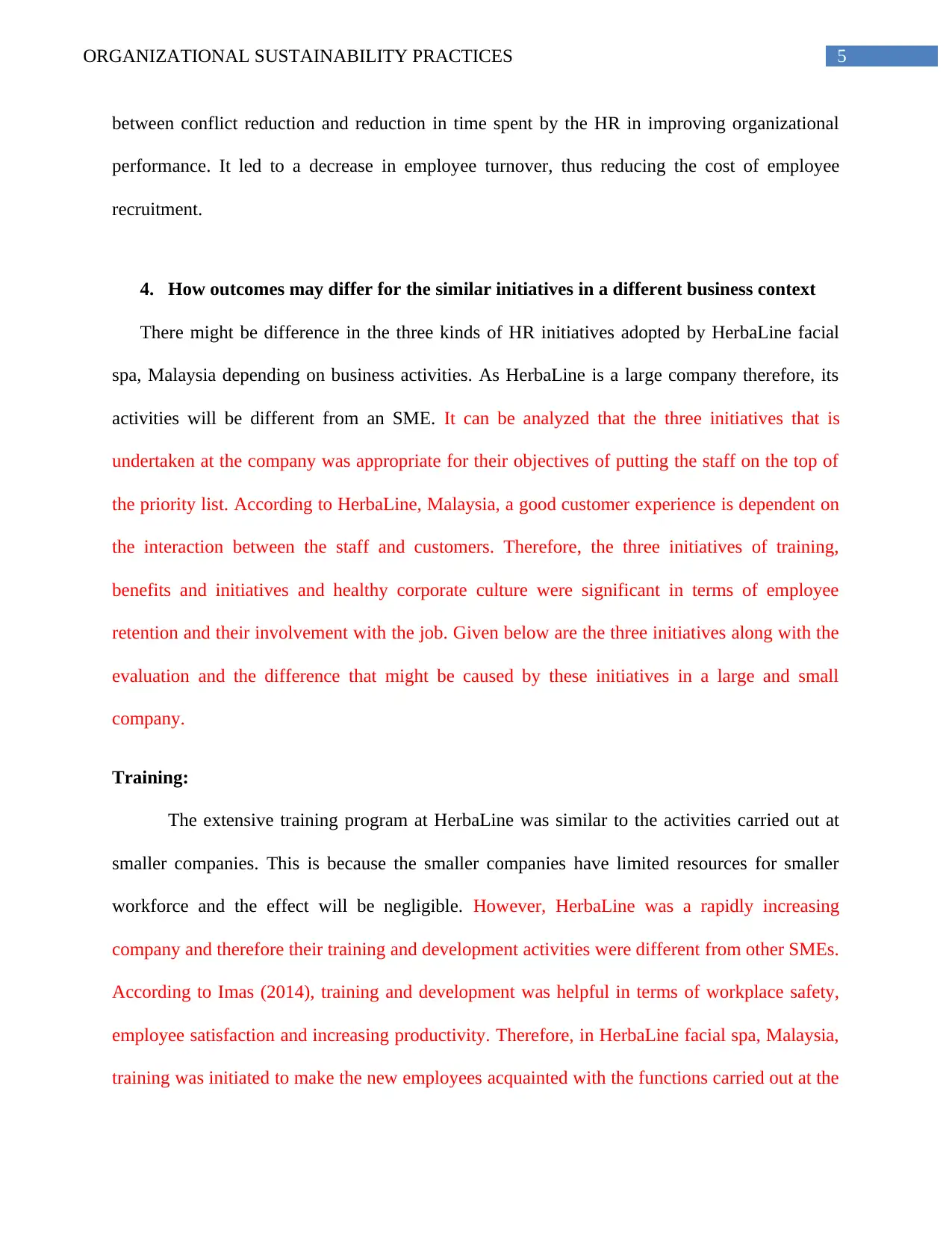
5ORGANIZATIONAL SUSTAINABILITY PRACTICES
between conflict reduction and reduction in time spent by the HR in improving organizational
performance. It led to a decrease in employee turnover, thus reducing the cost of employee
recruitment.
4. How outcomes may differ for the similar initiatives in a different business context
There might be difference in the three kinds of HR initiatives adopted by HerbaLine facial
spa, Malaysia depending on business activities. As HerbaLine is a large company therefore, its
activities will be different from an SME. It can be analyzed that the three initiatives that is
undertaken at the company was appropriate for their objectives of putting the staff on the top of
the priority list. According to HerbaLine, Malaysia, a good customer experience is dependent on
the interaction between the staff and customers. Therefore, the three initiatives of training,
benefits and initiatives and healthy corporate culture were significant in terms of employee
retention and their involvement with the job. Given below are the three initiatives along with the
evaluation and the difference that might be caused by these initiatives in a large and small
company.
Training:
The extensive training program at HerbaLine was similar to the activities carried out at
smaller companies. This is because the smaller companies have limited resources for smaller
workforce and the effect will be negligible. However, HerbaLine was a rapidly increasing
company and therefore their training and development activities were different from other SMEs.
According to Imas (2014), training and development was helpful in terms of workplace safety,
employee satisfaction and increasing productivity. Therefore, in HerbaLine facial spa, Malaysia,
training was initiated to make the new employees acquainted with the functions carried out at the
between conflict reduction and reduction in time spent by the HR in improving organizational
performance. It led to a decrease in employee turnover, thus reducing the cost of employee
recruitment.
4. How outcomes may differ for the similar initiatives in a different business context
There might be difference in the three kinds of HR initiatives adopted by HerbaLine facial
spa, Malaysia depending on business activities. As HerbaLine is a large company therefore, its
activities will be different from an SME. It can be analyzed that the three initiatives that is
undertaken at the company was appropriate for their objectives of putting the staff on the top of
the priority list. According to HerbaLine, Malaysia, a good customer experience is dependent on
the interaction between the staff and customers. Therefore, the three initiatives of training,
benefits and initiatives and healthy corporate culture were significant in terms of employee
retention and their involvement with the job. Given below are the three initiatives along with the
evaluation and the difference that might be caused by these initiatives in a large and small
company.
Training:
The extensive training program at HerbaLine was similar to the activities carried out at
smaller companies. This is because the smaller companies have limited resources for smaller
workforce and the effect will be negligible. However, HerbaLine was a rapidly increasing
company and therefore their training and development activities were different from other SMEs.
According to Imas (2014), training and development was helpful in terms of workplace safety,
employee satisfaction and increasing productivity. Therefore, in HerbaLine facial spa, Malaysia,
training was initiated to make the new employees acquainted with the functions carried out at the
⊘ This is a preview!⊘
Do you want full access?
Subscribe today to unlock all pages.

Trusted by 1+ million students worldwide
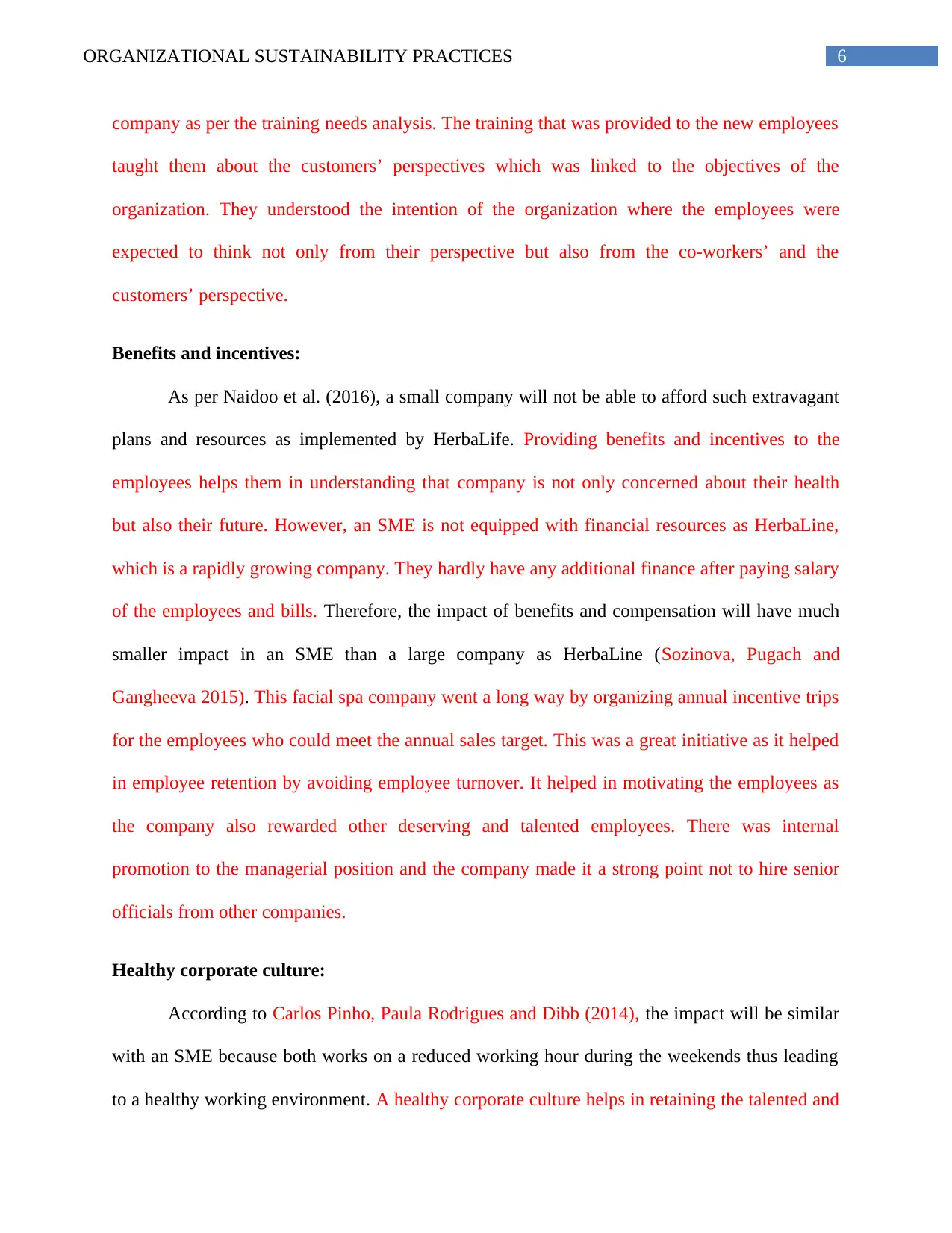
6ORGANIZATIONAL SUSTAINABILITY PRACTICES
company as per the training needs analysis. The training that was provided to the new employees
taught them about the customers’ perspectives which was linked to the objectives of the
organization. They understood the intention of the organization where the employees were
expected to think not only from their perspective but also from the co-workers’ and the
customers’ perspective.
Benefits and incentives:
As per Naidoo et al. (2016), a small company will not be able to afford such extravagant
plans and resources as implemented by HerbaLife. Providing benefits and incentives to the
employees helps them in understanding that company is not only concerned about their health
but also their future. However, an SME is not equipped with financial resources as HerbaLine,
which is a rapidly growing company. They hardly have any additional finance after paying salary
of the employees and bills. Therefore, the impact of benefits and compensation will have much
smaller impact in an SME than a large company as HerbaLine (Sozinova, Pugach and
Gangheeva 2015). This facial spa company went a long way by organizing annual incentive trips
for the employees who could meet the annual sales target. This was a great initiative as it helped
in employee retention by avoiding employee turnover. It helped in motivating the employees as
the company also rewarded other deserving and talented employees. There was internal
promotion to the managerial position and the company made it a strong point not to hire senior
officials from other companies.
Healthy corporate culture:
According to Carlos Pinho, Paula Rodrigues and Dibb (2014), the impact will be similar
with an SME because both works on a reduced working hour during the weekends thus leading
to a healthy working environment. A healthy corporate culture helps in retaining the talented and
company as per the training needs analysis. The training that was provided to the new employees
taught them about the customers’ perspectives which was linked to the objectives of the
organization. They understood the intention of the organization where the employees were
expected to think not only from their perspective but also from the co-workers’ and the
customers’ perspective.
Benefits and incentives:
As per Naidoo et al. (2016), a small company will not be able to afford such extravagant
plans and resources as implemented by HerbaLife. Providing benefits and incentives to the
employees helps them in understanding that company is not only concerned about their health
but also their future. However, an SME is not equipped with financial resources as HerbaLine,
which is a rapidly growing company. They hardly have any additional finance after paying salary
of the employees and bills. Therefore, the impact of benefits and compensation will have much
smaller impact in an SME than a large company as HerbaLine (Sozinova, Pugach and
Gangheeva 2015). This facial spa company went a long way by organizing annual incentive trips
for the employees who could meet the annual sales target. This was a great initiative as it helped
in employee retention by avoiding employee turnover. It helped in motivating the employees as
the company also rewarded other deserving and talented employees. There was internal
promotion to the managerial position and the company made it a strong point not to hire senior
officials from other companies.
Healthy corporate culture:
According to Carlos Pinho, Paula Rodrigues and Dibb (2014), the impact will be similar
with an SME because both works on a reduced working hour during the weekends thus leading
to a healthy working environment. A healthy corporate culture helps in retaining the talented and
Paraphrase This Document
Need a fresh take? Get an instant paraphrase of this document with our AI Paraphraser
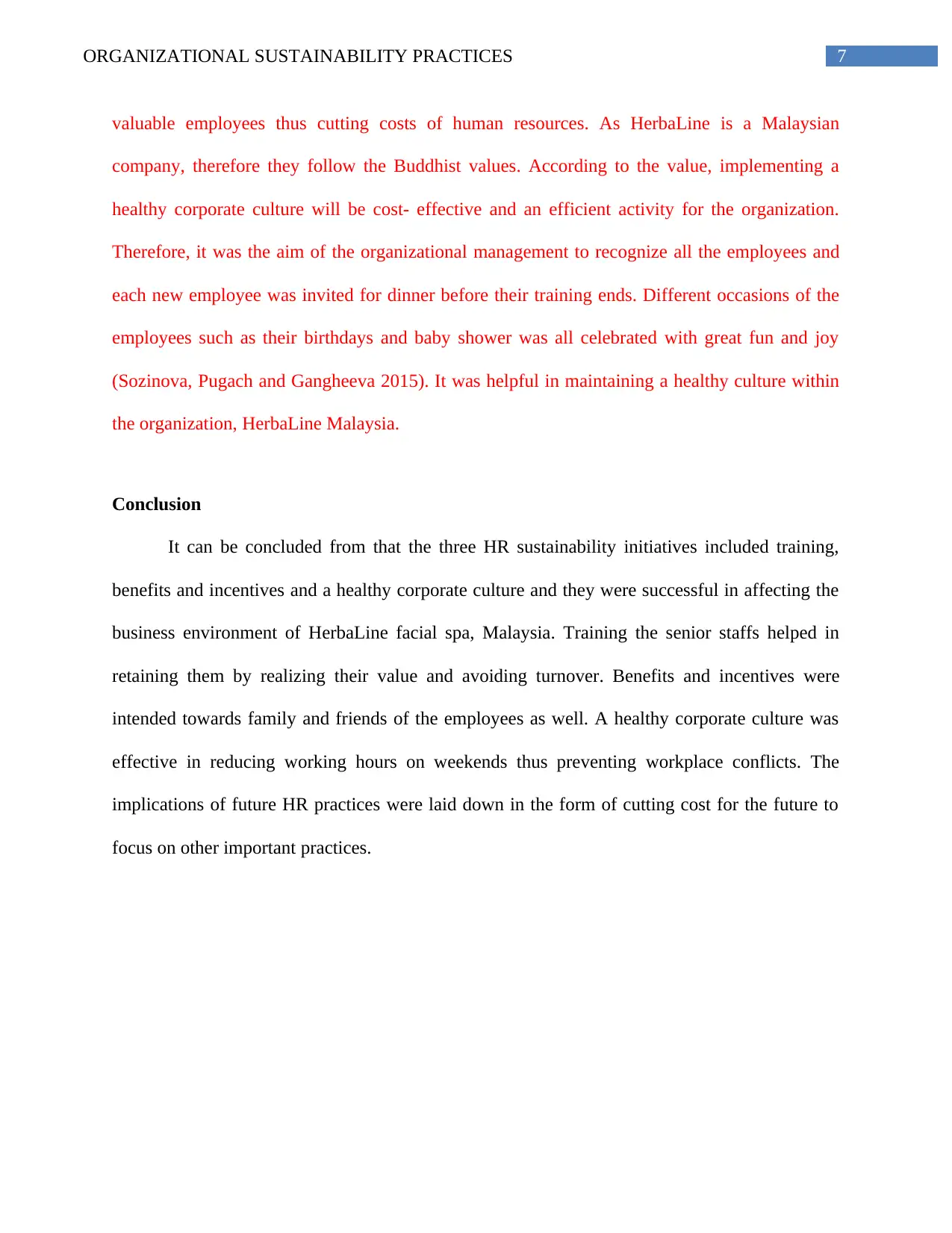
7ORGANIZATIONAL SUSTAINABILITY PRACTICES
valuable employees thus cutting costs of human resources. As HerbaLine is a Malaysian
company, therefore they follow the Buddhist values. According to the value, implementing a
healthy corporate culture will be cost- effective and an efficient activity for the organization.
Therefore, it was the aim of the organizational management to recognize all the employees and
each new employee was invited for dinner before their training ends. Different occasions of the
employees such as their birthdays and baby shower was all celebrated with great fun and joy
(Sozinova, Pugach and Gangheeva 2015). It was helpful in maintaining a healthy culture within
the organization, HerbaLine Malaysia.
Conclusion
It can be concluded from that the three HR sustainability initiatives included training,
benefits and incentives and a healthy corporate culture and they were successful in affecting the
business environment of HerbaLine facial spa, Malaysia. Training the senior staffs helped in
retaining them by realizing their value and avoiding turnover. Benefits and incentives were
intended towards family and friends of the employees as well. A healthy corporate culture was
effective in reducing working hours on weekends thus preventing workplace conflicts. The
implications of future HR practices were laid down in the form of cutting cost for the future to
focus on other important practices.
valuable employees thus cutting costs of human resources. As HerbaLine is a Malaysian
company, therefore they follow the Buddhist values. According to the value, implementing a
healthy corporate culture will be cost- effective and an efficient activity for the organization.
Therefore, it was the aim of the organizational management to recognize all the employees and
each new employee was invited for dinner before their training ends. Different occasions of the
employees such as their birthdays and baby shower was all celebrated with great fun and joy
(Sozinova, Pugach and Gangheeva 2015). It was helpful in maintaining a healthy culture within
the organization, HerbaLine Malaysia.
Conclusion
It can be concluded from that the three HR sustainability initiatives included training,
benefits and incentives and a healthy corporate culture and they were successful in affecting the
business environment of HerbaLine facial spa, Malaysia. Training the senior staffs helped in
retaining them by realizing their value and avoiding turnover. Benefits and incentives were
intended towards family and friends of the employees as well. A healthy corporate culture was
effective in reducing working hours on weekends thus preventing workplace conflicts. The
implications of future HR practices were laid down in the form of cutting cost for the future to
focus on other important practices.
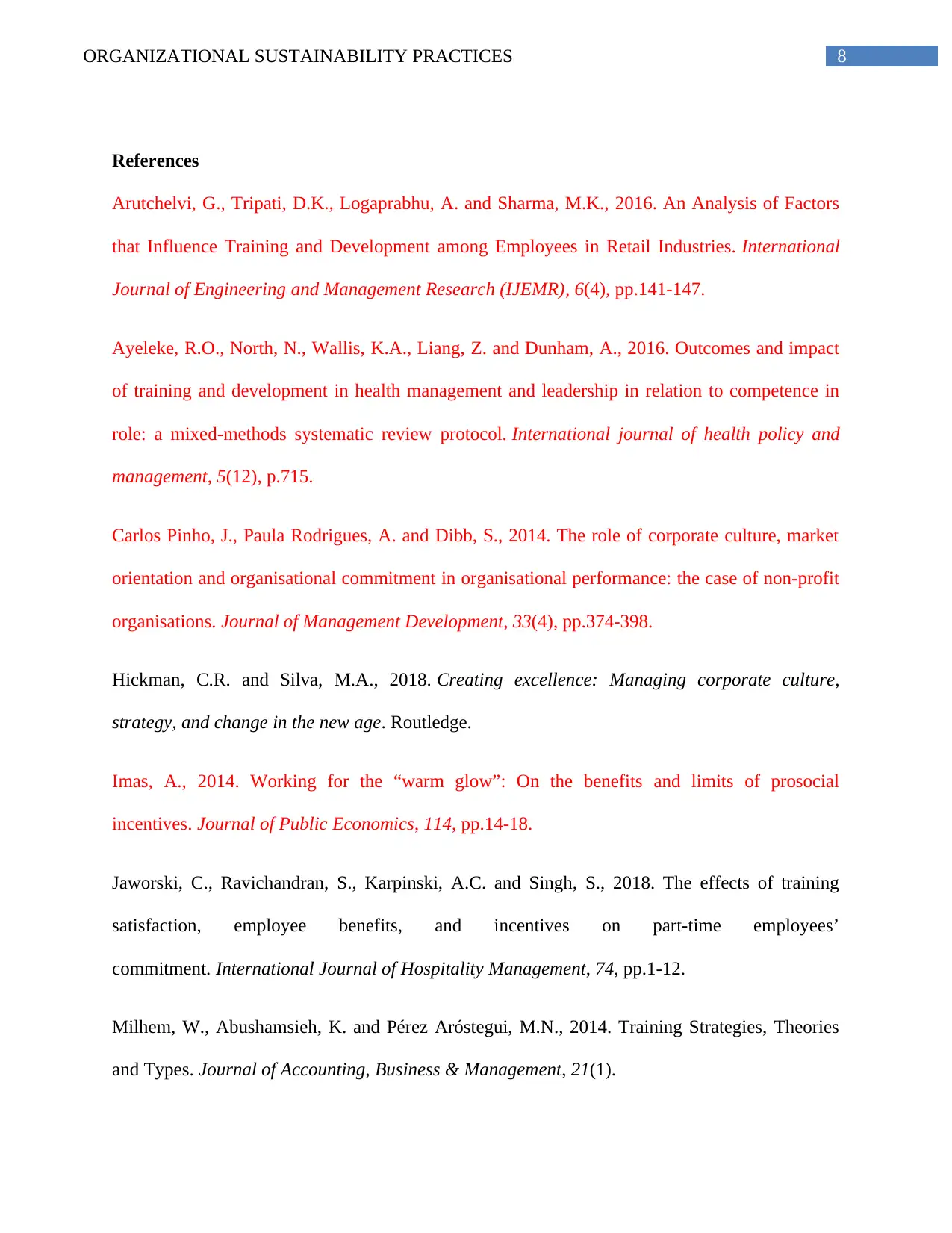
8ORGANIZATIONAL SUSTAINABILITY PRACTICES
References
Arutchelvi, G., Tripati, D.K., Logaprabhu, A. and Sharma, M.K., 2016. An Analysis of Factors
that Influence Training and Development among Employees in Retail Industries. International
Journal of Engineering and Management Research (IJEMR), 6(4), pp.141-147.
Ayeleke, R.O., North, N., Wallis, K.A., Liang, Z. and Dunham, A., 2016. Outcomes and impact
of training and development in health management and leadership in relation to competence in
role: a mixed-methods systematic review protocol. International journal of health policy and
management, 5(12), p.715.
Carlos Pinho, J., Paula Rodrigues, A. and Dibb, S., 2014. The role of corporate culture, market
orientation and organisational commitment in organisational performance: the case of non-profit
organisations. Journal of Management Development, 33(4), pp.374-398.
Hickman, C.R. and Silva, M.A., 2018. Creating excellence: Managing corporate culture,
strategy, and change in the new age. Routledge.
Imas, A., 2014. Working for the “warm glow”: On the benefits and limits of prosocial
incentives. Journal of Public Economics, 114, pp.14-18.
Jaworski, C., Ravichandran, S., Karpinski, A.C. and Singh, S., 2018. The effects of training
satisfaction, employee benefits, and incentives on part-time employees’
commitment. International Journal of Hospitality Management, 74, pp.1-12.
Milhem, W., Abushamsieh, K. and Pérez Aróstegui, M.N., 2014. Training Strategies, Theories
and Types. Journal of Accounting, Business & Management, 21(1).
References
Arutchelvi, G., Tripati, D.K., Logaprabhu, A. and Sharma, M.K., 2016. An Analysis of Factors
that Influence Training and Development among Employees in Retail Industries. International
Journal of Engineering and Management Research (IJEMR), 6(4), pp.141-147.
Ayeleke, R.O., North, N., Wallis, K.A., Liang, Z. and Dunham, A., 2016. Outcomes and impact
of training and development in health management and leadership in relation to competence in
role: a mixed-methods systematic review protocol. International journal of health policy and
management, 5(12), p.715.
Carlos Pinho, J., Paula Rodrigues, A. and Dibb, S., 2014. The role of corporate culture, market
orientation and organisational commitment in organisational performance: the case of non-profit
organisations. Journal of Management Development, 33(4), pp.374-398.
Hickman, C.R. and Silva, M.A., 2018. Creating excellence: Managing corporate culture,
strategy, and change in the new age. Routledge.
Imas, A., 2014. Working for the “warm glow”: On the benefits and limits of prosocial
incentives. Journal of Public Economics, 114, pp.14-18.
Jaworski, C., Ravichandran, S., Karpinski, A.C. and Singh, S., 2018. The effects of training
satisfaction, employee benefits, and incentives on part-time employees’
commitment. International Journal of Hospitality Management, 74, pp.1-12.
Milhem, W., Abushamsieh, K. and Pérez Aróstegui, M.N., 2014. Training Strategies, Theories
and Types. Journal of Accounting, Business & Management, 21(1).
⊘ This is a preview!⊘
Do you want full access?
Subscribe today to unlock all pages.

Trusted by 1+ million students worldwide
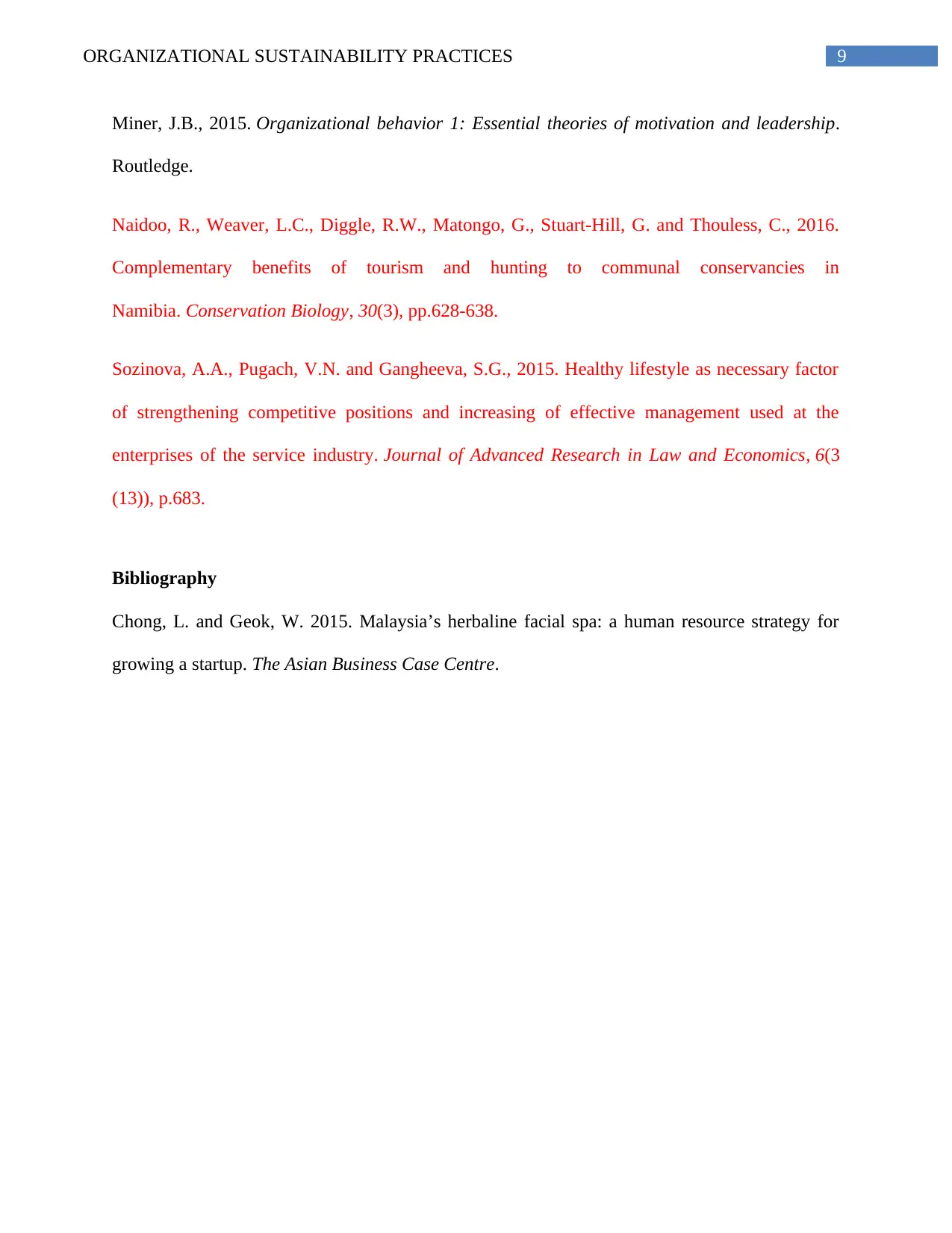
9ORGANIZATIONAL SUSTAINABILITY PRACTICES
Miner, J.B., 2015. Organizational behavior 1: Essential theories of motivation and leadership.
Routledge.
Naidoo, R., Weaver, L.C., Diggle, R.W., Matongo, G., Stuart‐Hill, G. and Thouless, C., 2016.
Complementary benefits of tourism and hunting to communal conservancies in
Namibia. Conservation Biology, 30(3), pp.628-638.
Sozinova, A.A., Pugach, V.N. and Gangheeva, S.G., 2015. Healthy lifestyle as necessary factor
of strengthening competitive positions and increasing of effective management used at the
enterprises of the service industry. Journal of Advanced Research in Law and Economics, 6(3
(13)), p.683.
Bibliography
Chong, L. and Geok, W. 2015. Malaysia’s herbaline facial spa: a human resource strategy for
growing a startup. The Asian Business Case Centre.
Miner, J.B., 2015. Organizational behavior 1: Essential theories of motivation and leadership.
Routledge.
Naidoo, R., Weaver, L.C., Diggle, R.W., Matongo, G., Stuart‐Hill, G. and Thouless, C., 2016.
Complementary benefits of tourism and hunting to communal conservancies in
Namibia. Conservation Biology, 30(3), pp.628-638.
Sozinova, A.A., Pugach, V.N. and Gangheeva, S.G., 2015. Healthy lifestyle as necessary factor
of strengthening competitive positions and increasing of effective management used at the
enterprises of the service industry. Journal of Advanced Research in Law and Economics, 6(3
(13)), p.683.
Bibliography
Chong, L. and Geok, W. 2015. Malaysia’s herbaline facial spa: a human resource strategy for
growing a startup. The Asian Business Case Centre.
1 out of 10
Related Documents
Your All-in-One AI-Powered Toolkit for Academic Success.
+13062052269
info@desklib.com
Available 24*7 on WhatsApp / Email
![[object Object]](/_next/static/media/star-bottom.7253800d.svg)
Unlock your academic potential
Copyright © 2020–2025 A2Z Services. All Rights Reserved. Developed and managed by ZUCOL.





